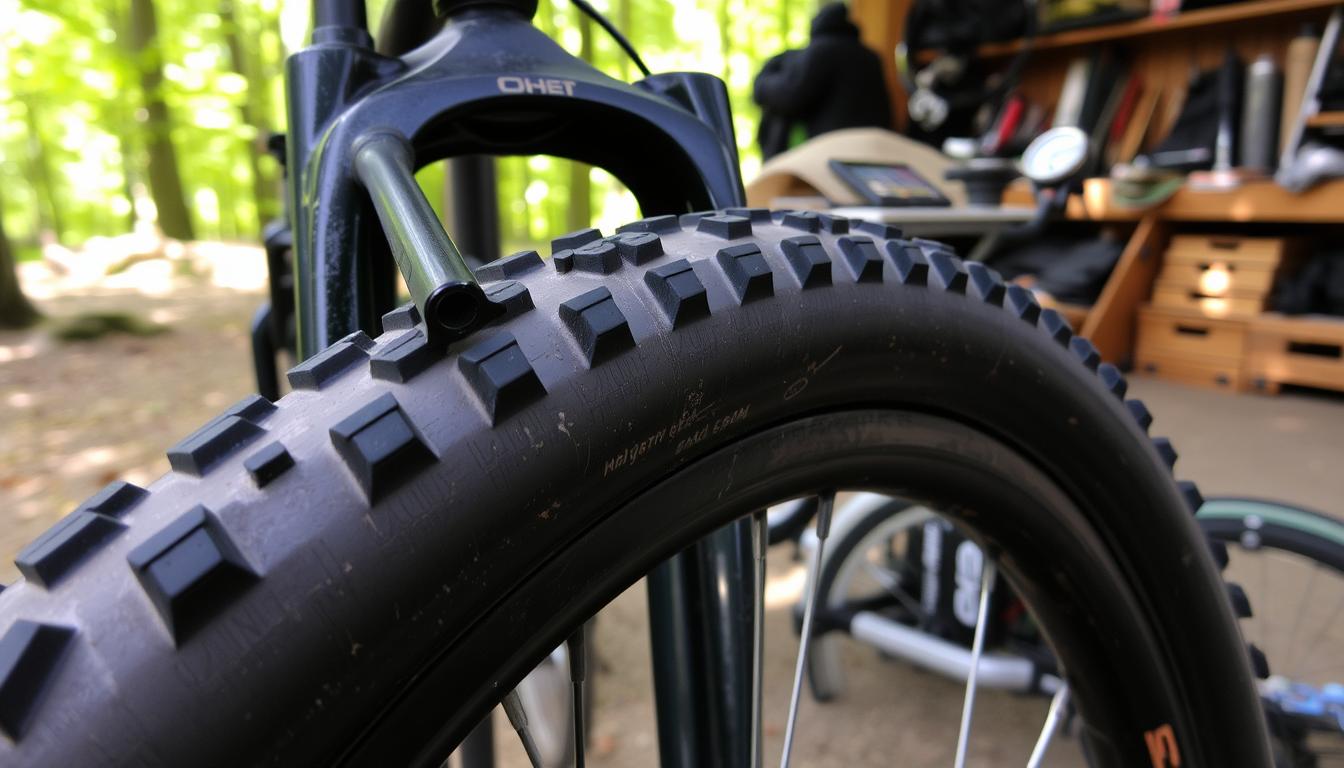Knowing when to replace your mountain bike tires is key for top performance and safety. Worn-out tires can make your bike less efficient, more prone to punctures, and less safe. Keeping up with mountain bike tire maintenance is vital to enjoy your bike to the fullest. This guide will help you spot when it’s time for new tires and why regular checks are important.
Key Takeaways
- Regular inspections are crucial to determine when to replace mtb tires.
- Mountain bike tire maintenance is essential for optimal performance and safety.
- Worn-out tires can lead to decreased performance and increased risk of punctures.
- Replacing MTB tires at the right time can extend the lifespan of your bike.
- Understanding the signs of wear is vital for making informed decisions about tire replacement.
- When to replace mtb tires depends on various factors, including riding style and terrain.
- Proper mountain bike tire maintenance can help prevent accidents and improve overall riding experience.
Understanding MTB Tire Wear Patterns
Mountain bike tire maintenance is key for top performance and safety. Knowing when to replace tires is crucial. There are three main types of tire wear: center tread, side knob, and casing damage.
Center tread wear means the middle of the tire wears down. This reduces traction and increases the chance of punctures. Side knob deterioration affects cornering and stability. Casing damage, like cracks or tears, can cause tire failure and accidents.
Riders should check their tires often for damage. The 50-percent wear mark is a key point where performance drops. It’s wise to replace tires before they get too worn to ensure safety and reliability.
| Tire Wear Type | Description | Consequences |
|---|---|---|
| Center Tread Wear | Worn down middle part of the tire | Reduced traction, increased puncture risk |
| Side Knob Deterioration | Worn down knobs on the side of the tire | Affected cornering and stability |
| Casing Damage Signs | Cracks or tears in the tire casing | Tire failure, accidents |
Regular checks and maintenance can make mtb tires last longer and prevent accidents. By understanding these wear patterns and taking action, riders can stay safe and perform well on trails.
Key Signs That It’s Time to Replace MTB Tires
It’s important to check your mountain bike tires often for safety and performance. Most riders get 500 to 1000 miles from a tire set. Look at how you ride, how often, and how well you maintain them to know when to replace them.
Mountain bike tires on pavement wear out faster because of friction and weight. Your riding style also affects how long they last.
Signs you need new tires include less grip, visible wear, and damage. Look for holes, worn-out knobs, cracks, blisters, or if your tires don’t grip well anymore. Cheaper tires need to be replaced more often than expensive ones.
Knowing when to change your tires is key to riding safely and well. Popular tires like Maxxis Rekon, Bontrager XR 4, and Vittoria Mazza Enduro are durable and versatile. Pick a tire that fits your riding style and terrain.
Replace your tires when they’ve lost half their tread depth. Regular checks and care can make your tires last longer. Recognizing when to replace them helps you stay safe and ride better.
| Tire Type | Lifespan | Replacement Indicator |
|---|---|---|
| Mountain Bike Tires | 3,000 – 8,000 miles | 50% tread depth loss |
| Cross-Country Tires | 500 – 1,000 miles | Visible wear, decreased traction |
| Enduro Tires | 1,000 – 3,000 miles | Damage to sidewalls or tread |
The Impact of Riding Style on Tire Longevity
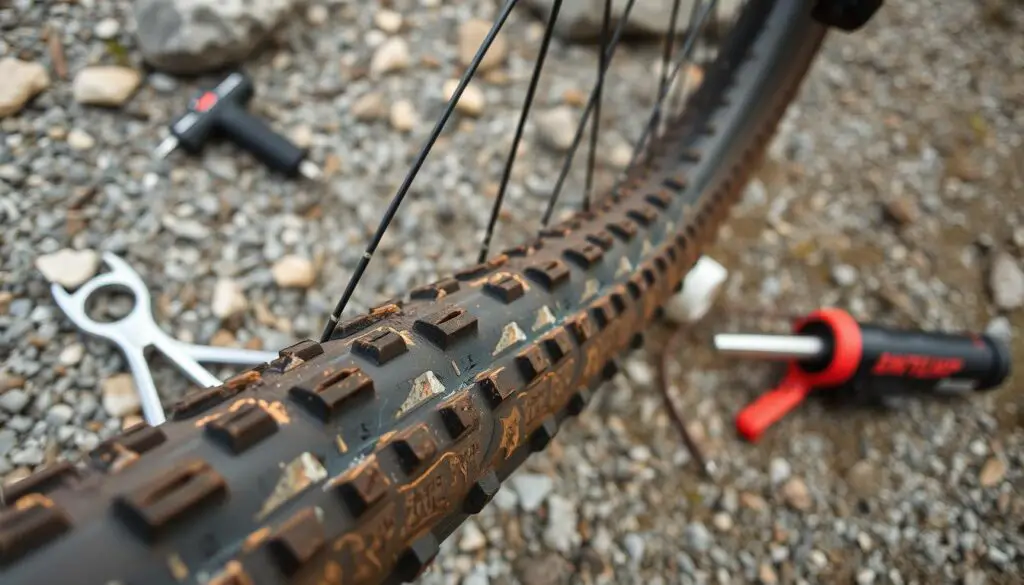
Riding style greatly affects how long mountain bike tires last. Smooth riding can make tires last longer. But, doing tricks and skidding can wear them out faster. It’s key to think about the terrain and your riding style when deciding when to upgrade mtb tires.
Trail riding and downhill riding have different effects on tires. Trail riding is smoother, which can make tires last longer. Downhill riding, with its rough terrain, wears tires out quicker. Keeping up with mountain bike tire maintenance is vital, no matter your riding style.
Here are some things to think about when looking at how riding style affects tire life:
- Terrain: Smooth roads make tires last longer, but rough gravel or rocks wear them down faster.
- Tire pressure: Lower pressure gives better grip and a smoother ride, but might increase the chance of getting a flat.
- Riding frequency: MTBs ridden often or on tough terrains might need tire changes more often.
Regular mountain bike tire maintenance and thinking about your riding style can help tires last longer. By understanding how riding style affects tire life, riders can keep their tires in good shape. This helps them decide when it’s time to upgrade mtb tires.
| Riding Style | Tire Longevity |
|---|---|
| Trail Riding | 6,000 – 8,000 miles |
| Downhill Riding | 3,000 – 5,000 miles |
| Cross-Country Riding | 5,000 – 7,000 miles |
Measuring Tread Depth and Wear Indicators
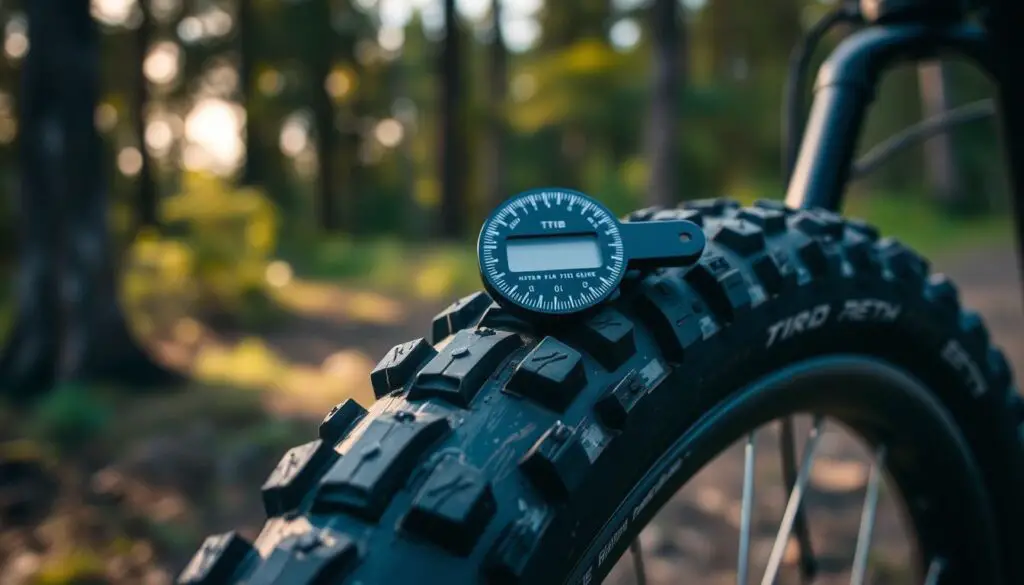
It’s important to check your MTB tires’ tread depth and look for wear indicators. This keeps you safe and helps your bike perform well. Knowing when to replace your tires can greatly improve your ride.
To measure tread depth, you can use a tool like the Bontrager Tire Tread Depth Gauge. It costs $24.99. This tool shows when your tire has reached its best miles. Tires start to lose grip after the first 10-15% of tread wears off.
Here are some key indicators to look out for:
- Centerline tread wear: Rear tires wear down faster than front tires.
- Knob wear: Knobby tires are worn out when the knobs on the centerline are gone.
- Tire bead wire or kevlar visibility: When the rubber wears off, you’ll see the tire bead wire or kevlar. This means it’s time to replace the tire.
By watching for these signs and knowing when to change your tires, you can keep them in good shape. This ensures a safe and fun ride every time.
Common Tire Damage That Requires Immediate Replacement
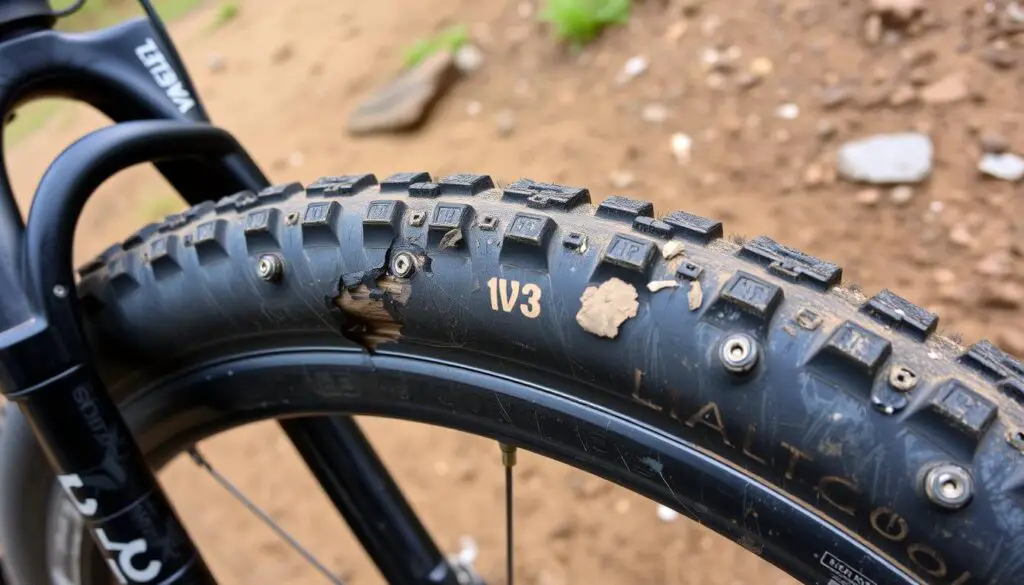
Knowing when to replace mountain bike tires is key for safety and performance. Some damage can be very risky for riders. It’s important to spot these issues to avoid accidents.
Sidewall cuts and tears are a big concern. They can cause punctures and more damage. Bead damage also matters, as it can make the tire lose air and shape.
Punctures are another big worry. They can make it hard to control the bike and lead to accidents. Checking tires often is crucial to catch these problems early.
Signs like exposed casing, holes, and cuts mean a tire needs to be replaced fast. If a tire gets punctures often, it’s time for a new one. Keeping up with tire maintenance and knowing when to replace tires can help avoid accidents.
Sidewall Cuts and Tears
Sidewall cuts and tears are big problems. They can cause more damage and punctures. It’s important to check tires often for damage and act quickly.
Bead Damage Assessment
Bead damage is hard to spot but must be found early. Regular checks and care can stop bead damage. This keeps the tire in good shape.
Puncture Evaluation
Punctures are a big worry, even more so if they happen a lot. It’s important to check the tire’s condition and take action. This helps prevent more punctures and keeps you safe.
How Weather and Terrain Affect Tire Lifespan
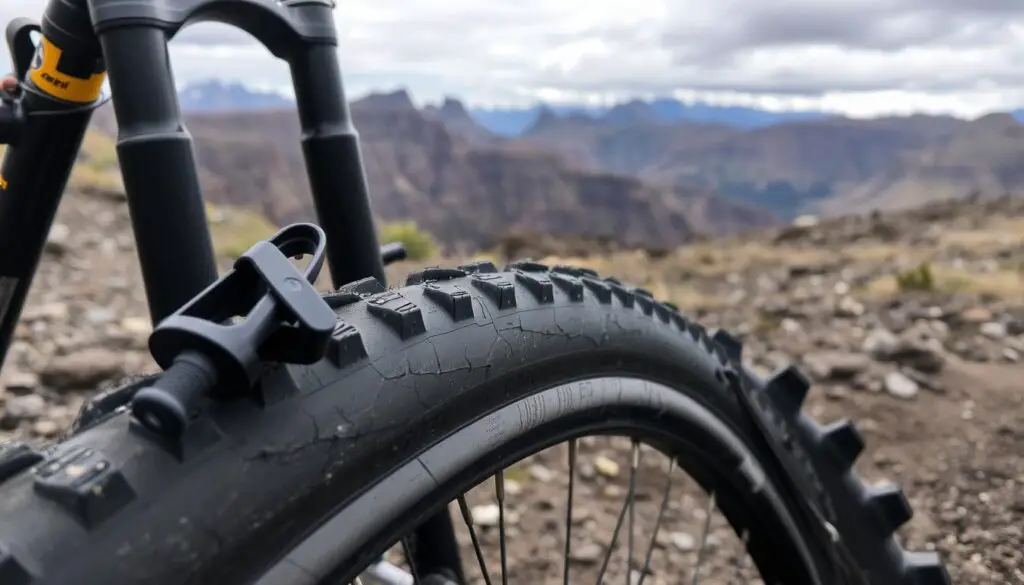
Mountain bike tire maintenance is key for a safe and fun ride. Many riders wonder when to replace their mtb tires. The answer often depends on the weather and terrain.
Extreme temperatures, rain, and rough trails can shorten tire life. Regular mountain bike tire maintenance helps extend their life. Look for signs of wear like cracks and blisters.
Riders should also consider the terrain. Rough trails and extreme weather can wear tires faster.
Some important factors to think about include:
- Terrain type: Rough trails, rocky terrain, and sandy or muddy conditions can all cause more wear and tear on mtb tires.
- Weather conditions: Extreme temperatures, rain, and snow can all impact the lifespan of mtb tires.
- Frequency of use: Riders who use their bikes frequently may need to replace their tires more often.
Proper mountain bike tire maintenance and storage also matter. Store bikes in a dry, cool place. Avoid extreme temperatures. These steps help extend tire life and ensure a safe ride.
Seasonal Considerations for MTB Tire Replacement
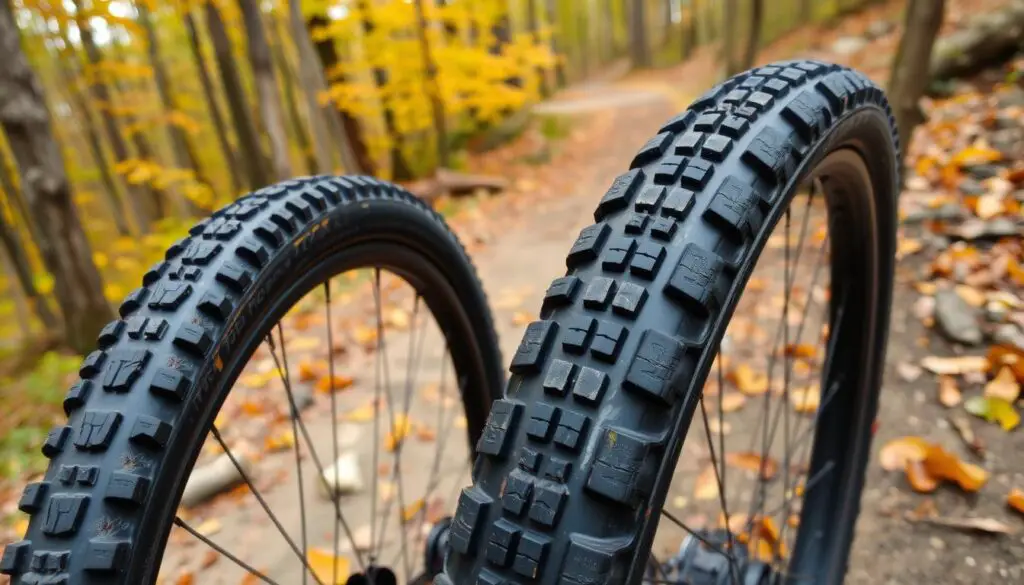
As seasons change, your MTB tires face different challenges. The right time to replace them depends on the season and how often you ride. For example, moving from summer to fall means checking your tires for wear.
Many riders wonder when to upgrade their tires. A common advice is to replace them every 4-6 weeks. But this can change based on where you ride, the weather, and how well you maintain your bike.
Summer to Fall Transition
When summer turns to fall, inspect your tires for wear and damage. Look for tread wear, sidewall cracks, and punctures. If you find any, it might be time for new tires.
Winter Riding Preparations
Before winter, check your tires and think about replacing them if needed. Keeping your bike in a controlled temperature helps prevent tire damage. It’s wise to wait a few weeks before the riding season to swap out tires that won’t be used for months.
Spring Maintenance Timing
In spring, regular bike maintenance is key, including tire checks. Replace tires if they’re worn or damaged. A good MTB tire usually lasts about 5,000 kilometers, but this can vary based on how you ride and the tire’s quality.
- Regularly inspecting your tires for wear and damage
- Replacing your tires every 4-6 weeks, depending on your riding frequency and style
- Storing your bike in a temperature-controlled environment during the winter
- Waiting until a few weeks before the riding season to replace tires that won’t be used for several months
By following these tips and considering the best time to replace your MTB tires, you can stay safe and perform well on trails. Always remember to keep up with regular maintenance and inspections to maximize your tire’s life.
Understanding Tire Age and Storage Impact
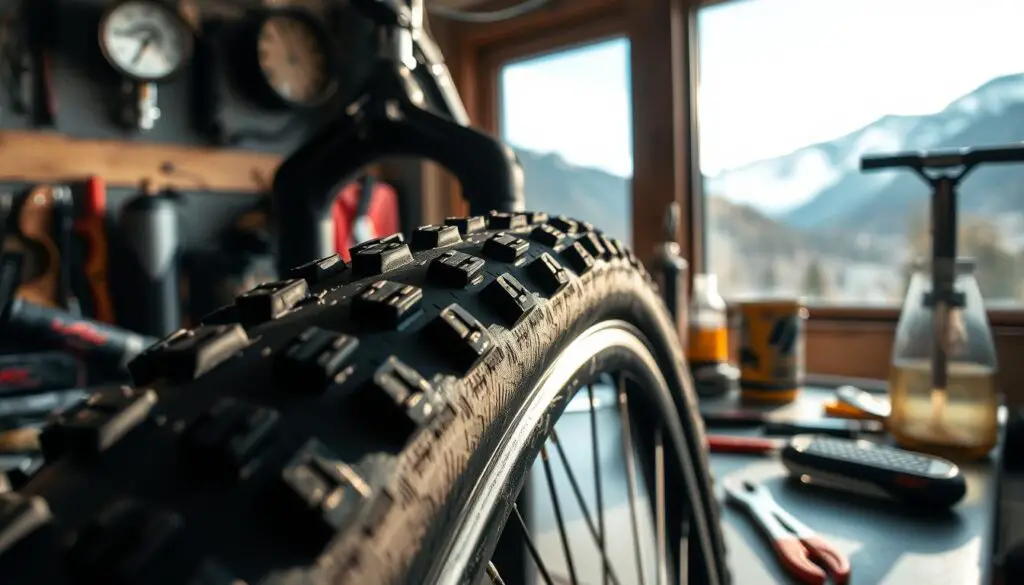
Proper mountain bike tire maintenance is key to making your tires last longer. Knowing when to replace your mtb tires depends on their age and how they’re stored. Tires can get old and crack if they’re not good quality, stored on bare concrete, or exposed to too much pressure or sunlight.
Signs of an old tire include cracked tread, damaged sidewalls, and rotten areas. To stop tires from deforming, it’s best to lower the pressure when you’re not riding. Keeping your bike indoors in temperatures between 15 and 25°C helps prevent tire aging. But, direct sunlight, which is worse in hot summers, can make tires age and crack faster.
- Avoiding extreme temperatures, like heat
- Storing tires in cool, dark places to slow down wear
- Keeping tires away from UV and ozone to make them last longer
It’s important to check and replace tires regularly based on their age and wear. By understanding how tire age and storage affect them, you can keep your mountain bike tires in top shape. This ensures you stay safe and perform well while cycling.
| Tire Type | Average Lifespan |
|---|---|
| Road Tires | 1,500 – 3,000 miles |
| Mountain Bike Tires | Varies depending on usage and conditions |
Professional vs DIY Tire Assessment Methods
When checking your MTB tires, you can choose between a professional or DIY approach. Each has its own advantages and drawbacks. A professional will inspect your tires at a reputable shop and give you a detailed report. This is a good choice if you’re not sure about your tires or if your bike keeps having problems.
DIY tire checks let you inspect your tires at home with special tools. It’s cheaper and more convenient. But, you need to know how to maintain and inspect your tires properly. Mountain bike tire maintenance is key to staying safe while riding. Knowing when to upgrade mtb tires can prevent accidents and enhance your ride.
Tools for Home Inspection
To check your tires at home, you’ll need a few tools. These include a tire pressure gauge, a tread depth gauge, and a tire lever. These tools help you check air pressure, tread depth, and overall condition. You can also find online resources for mountain bike tire maintenance and when to upgrade mtb tires.
When to Seek Expert Opinion
DIY checks are useful, but sometimes you need a professional’s help. If you’re unsure about your tires or if your bike keeps having issues, take it to a shop. A mechanic can do a thorough check and suggest repairs or replacements. Regular mountain bike tire maintenance can make your tires last longer and improve your ride. Knowing when to upgrade mtb tires ensures your safety and performance.
In conclusion, both professional and DIY tire checks have their uses. Understanding mountain bike tire maintenance and when to upgrade mtb tires helps you make smart choices for your bike. This ensures your safety and enjoyment on the trails.
| Tire Condition | Recommended Action |
|---|---|
| Good condition | Continue riding and maintain regular tire pressure checks |
| Worn out | Replace tires and consider professional assessment for other components |
| Damaged | Seek professional opinion and repair or replace tires as needed |
Preventive Maintenance to Extend Tire Life
Regular mountain bike tire maintenance is key to making your tires last longer. Always check the tire pressure before you ride. This keeps your tires inflated right and prevents flats.
Also, look over your tires for any signs of wear or damage. Watch for cuts, tears, and worn-out tread. Spotting these early can stop more damage and make your tires last longer.
Here are some other ways to keep your tires in good shape:
- Check hub integrity and wheel trueness before each ride
- Lube your chain every 2-3 hours of riding
- Inspect brake pads every 3-5 rides, specially after wet rides
- Check shock/fork air pressure now and then
By doing these simple things, you can make your tires last longer and ride better. Don’t forget to check how often to change mtb tires to get the best from them.
Regular care can also stop common problems like flat tires. Keep your tires at the right pressure and check them often. This helps avoid flats and keeps your ride smooth.
| Maintenance Task | Frequency |
|---|---|
| Check tire pressure | Every ride |
| Inspect tires for wear and damage | Every 1-2 weeks |
| Lube chain | Every 2-3 hours of riding |
| Inspect brake pads | Every 3-5 rides |
Conclusion: Making the Right Tire Replacement Decision
Keeping your mountain bike tires in top shape is key for great performance, safety, and a longer bike life. It’s important to check your tires often for wear signs like tread loss, cuts, and punctures. This helps you know when it’s time to replace them.
Regular care for your mountain bike tires can stop flats, cut down on resistance, and make your rides better. Knowing what affects tire life, like how you ride, the weather, and the terrain, helps you keep your tires in top condition.
Always check your tire pressure before you ride. Properly inflated tires can greatly improve your bike’s performance and safety. Also, think about the cost of new tires, which can be between $30 and $100. This depends on the tire’s durability and performance.
By following these tips and keeping up with your mountain bike tire maintenance, you’ll have a safer and more fun ride. Regular checks and maintenance are crucial. This ensures your tires are ready to go, and you know when it’s time for a new set.

I am Ryan Ford, a mountain biking enthusiast who loves to explore the outdoors. I also like to go on adventures with friends and anything else that involves being outside. I love my bike because it gets me out of the house and gives me an opportunity to enjoy nature.

